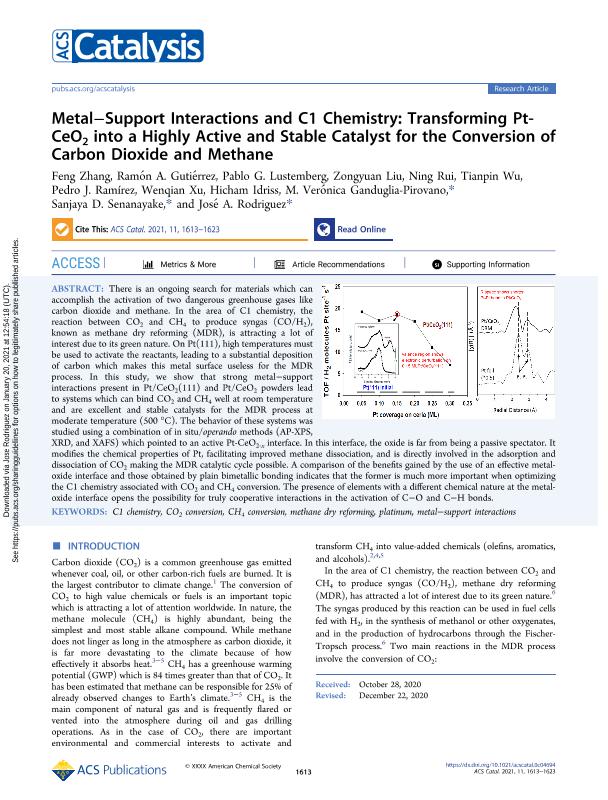Mostrar el registro sencillo del ítem
dc.contributor.author
Zhang, Feng
dc.contributor.author
Gutiérrez, Ramón A.
dc.contributor.author
Lustemberg, Pablo German

dc.contributor.author
Liu, Zongyuan
dc.contributor.author
Rui, Ning
dc.contributor.author
Wu, Tianpin
dc.contributor.author
Ramírez, Pedro J.
dc.contributor.author
Xu, Wenqian
dc.contributor.author
Idriss, Hicham
dc.contributor.author
Ganduglia Pirovano, M. Verónica
dc.contributor.author
Senanayake, Sanjaya D.
dc.contributor.author
Rodriguez, José A.
dc.date.available
2023-01-11T17:23:07Z
dc.date.issued
2021-02
dc.identifier.citation
Zhang, Feng; Gutiérrez, Ramón A.; Lustemberg, Pablo German; Liu, Zongyuan; Rui, Ning; et al.; Metal-Support Interactions and C1 Chemistry: Transforming Pt-CeO2into a Highly Active and Stable Catalyst for the Conversion of Carbon Dioxide and Methane; American Chemical Society; ACS Catalysis; 11; 3; 2-2021; 1613-1623
dc.identifier.uri
http://hdl.handle.net/11336/184386
dc.description.abstract
There is an ongoing search for materials which can accomplish the activation of two dangerous greenhouse gases like carbon dioxide and methane. In the area of C1 chemistry, the reaction between CO2 and CH4 to produce syngas (CO/H2), known as methane dry reforming (MDR), is attracting a lot of interest due to its green nature. On Pt(111), high temperatures must be used to activate the reactants, leading to a substantial deposition of carbon which makes this metal surface useless for the MDR process. In this study, we show that strong metal-support interactions present in Pt/CeO2(111) and Pt/CeO2 powders lead to systems which can bind CO2 and CH4 well at room temperature and are excellent and stable catalysts for the MDR process at moderate temperature (500 °C). The behavior of these systems was studied using a combination of in situ/operando methods (AP-XPS, XRD, and XAFS) which pointed to an active Pt-CeO2-x interface. In this interface, the oxide is far from being a passive spectator. It modifies the chemical properties of Pt, facilitating improved methane dissociation, and is directly involved in the adsorption and dissociation of CO2 making the MDR catalytic cycle possible. A comparison of the benefits gained by the use of an effective metal-oxide interface and those obtained by plain bimetallic bonding indicates that the former is much more important when optimizing the C1 chemistry associated with CO2 and CH4 conversion. The presence of elements with a different chemical nature at the metal-oxide interface opens the possibility for truly cooperative interactions in the activation of C-O and C-H bonds.
dc.format
application/pdf
dc.language.iso
eng
dc.publisher
American Chemical Society

dc.rights
info:eu-repo/semantics/openAccess
dc.rights.uri
https://creativecommons.org/licenses/by/2.5/ar/
dc.subject
C1 CHEMISTRY
dc.subject
CH4CONVERSION
dc.subject
CO2CONVERSION
dc.subject
METAL-SUPPORT INTERACTIONS
dc.subject
METHANE DRY REFORMING
dc.subject
PLATINUM
dc.subject.classification
Otras Ciencias Químicas

dc.subject.classification
Ciencias Químicas

dc.subject.classification
CIENCIAS NATURALES Y EXACTAS

dc.title
Metal-Support Interactions and C1 Chemistry: Transforming Pt-CeO2into a Highly Active and Stable Catalyst for the Conversion of Carbon Dioxide and Methane
dc.type
info:eu-repo/semantics/article
dc.type
info:ar-repo/semantics/artículo
dc.type
info:eu-repo/semantics/publishedVersion
dc.date.updated
2022-09-21T14:28:22Z
dc.identifier.eissn
2155-5435
dc.journal.volume
11
dc.journal.number
3
dc.journal.pagination
1613-1623
dc.journal.pais
Estados Unidos

dc.description.fil
Fil: Zhang, Feng. State University of New York. Stony Brook University; Estados Unidos
dc.description.fil
Fil: Gutiérrez, Ramón A.. Universidad Central de Venezuela; Venezuela
dc.description.fil
Fil: Lustemberg, Pablo German. Consejo Nacional de Investigaciones Científicas y Técnicas. Centro Científico Tecnológico Conicet - Rosario. Instituto de Física de Rosario. Universidad Nacional de Rosario. Instituto de Física de Rosario; Argentina. Consejo Superior de Investigaciones Científicas; España
dc.description.fil
Fil: Liu, Zongyuan. Brookhaven National Laboratory; Estados Unidos
dc.description.fil
Fil: Rui, Ning. Brookhaven National Laboratory; Estados Unidos
dc.description.fil
Fil: Wu, Tianpin. Argonne National Laboratory; Estados Unidos
dc.description.fil
Fil: Ramírez, Pedro J.. Zoneca-cenex; México. Universidad Central de Venezuela; Venezuela
dc.description.fil
Fil: Xu, Wenqian. Argonne National Laboratory; Estados Unidos
dc.description.fil
Fil: Idriss, Hicham. King Abdullah University of Science and Technology; Arabia Saudita
dc.description.fil
Fil: Ganduglia Pirovano, M. Verónica. Consejo Superior de Investigaciones Científicas; España
dc.description.fil
Fil: Senanayake, Sanjaya D.. Brookhaven National Laboratory; Estados Unidos
dc.description.fil
Fil: Rodriguez, José A.. Brookhaven National Laboratory; Estados Unidos. State University of New York. Stony Brook University; Estados Unidos
dc.journal.title
ACS Catalysis
dc.relation.alternativeid
info:eu-repo/semantics/altIdentifier/doi/http://dx.doi.org/10.1021/acscatal.0c04694
dc.relation.alternativeid
info:eu-repo/semantics/altIdentifier/url/https://pubs.acs.org/doi/10.1021/acscatal.0c04694
Archivos asociados
